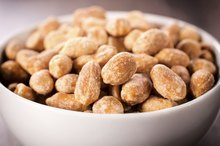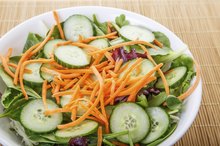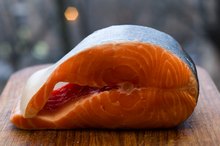How To Reduce Fatty Deposits in Arteries
The buildup of fatty deposits, or plaque, in the arteries is medically referred to as atherosclerosis. While some accumulation of fatty deposits in the arteries is normal, excess buildup hardens and narrows the arteries making it difficult for blood to flow through. This increases your risk of developing heart disease and experiencing a heart attack. Making several lifestyle changes is often the best way to reduce fatty deposits in the arteries.
If you are experiencing serious medical symptoms, seek emergency treatment immediately.
Quit smoking. Cigarette smoke damages your arteries, making you more susceptible to atherosclerosis. Quitting smoking can slow the progression of atherosclerosis. If you are a smoker, quit immediately.
How to Lose One Pound a Week
Learn More
Exercise regularly. Aim for 30 to 60 minutes of cardiovascular exercise, such as walking, swimming or biking, every day. If you can’t dedicate 30 straight minutes to exercise, split your exercise up into intervals. Do 10 minutes in the morning, 10 minutes in the afternoon and 10 minutes after dinner.
Monitor fat intake. Fat contributes to high cholesterol, which causes the buildup of fatty deposits in the arteries. Limit total fat intake to 25 to 35 percent of calories. Reduce saturated fat to less than 7 percent of calories and trans fat to less than 1 percent of calories.
How to Dissolve Blood Clots With Exercise
Learn More
Reduce cholesterol intake. Cholesterol in your diet also increases fatty deposits in your arteries. Because your body makes all the cholesterol you need, you don’t have to eat any cholesterol. Keep your cholesterol intake below 300 mg per day.
Increase fruits and vegetables. Fruits and vegetables contain compounds called plant stenols, that help lower your cholesterol. Aim for 3 to 5 servings each of fruits and vegetables. Vary the nutrients you consume by choosing different colored fruits and vegetables. Try a new fruit or vegetable each week.
Limit alcoholic beverages. Alcohol increases the amount of triglycerides, another type of lipid that contributes to atherosclerosis, in your blood. Limit alcohol intake to two drinks per day if you are a man and one drink per day if you are a woman. A single drink is defined as one beer, a small glass of wine or 1 oz. of hard liquor.
Manage stress. A stressful event, especially one that involves anger, is the most common trigger for a heart attack, according to the National Heart, Lung and Blood Institute 1. Reduce your stress level by getting involved in stress reduction activities, such as yoga and deep breathing. Confide in and share your problems with family members or close friends whenever you are feeling stressed.
Warnings
Talk to your doctor before you begin a new exercise routine.
Related Articles
References
- National Heart, Lung and Blood Institute; Atherosclerosis
- "Nutrition and You"; Joan Salge Blake; 2008
- Siasos G, Tsigkou V, Kokkou E, et al. Smoking and atherosclerosis: mechanisms of disease and new therapeutic approaches. Curr Med Chem. 2014;21(34):3936–3948. doi:10.2174/092986732134141015161539
- Gimbrone MA Jr, García-Cardeña G. Endothelial Cell Dysfunction and the Pathobiology of Atherosclerosis. Circ Res. 2016;118(4):620–636. doi:10.1161/CIRCRESAHA.115.306301
- Musani MH, Musani MA, Verardi MA. Venous gangrene a rare but dreadful complication of deep venous thrombosis. Clin Appl Thromb Hemost. 2011;17(6):E1–E3. doi:10.1177/1076029610376629
- Kim JA, Montagnani M, Chandrasekran S, Quon MJ. Role of lipotoxicity in endothelial dysfunction. Heart Fail Clin. 2012;8(4):589–607. doi:10.1016/j.hfc.2012.06.012
- Gronewold J, Kropp R, Lehmann N, et al. Cardiovascular Risk and Atherosclerosis Progression in Hypertensive Persons Treated to Blood Pressure Targets. Hypertension. 2019;74(6):1436–1447. doi:10.1161/HYPERTENSIONAHA.119.13827
- Rao Ch S, Subash Y E. The effect of chronic tobacco smoking and chewing on the lipid profile. J Clin Diagn Res. 2013;7(1):31–34. doi:10.7860/JCDR/2012/5086.2663
- Leone A. How and why chemicals from tobacco smoke can induce a rise in blood pressure. World J Pharmacol. 2012;1(1):10-20.doi:10.5497/wjp.v1.i1.10
- Virdis A, Giannarelli C, Neves MF, Taddei S, Ghiadoni L. Cigarette smoking and hypertension. Curr Pharm Des. 2010;16(23):2518–2525. doi:10.2174/138161210792062920
- Shah RS, Cole JW. Smoking and stroke: the more you smoke the more you stroke. Expert Rev Cardiovasc Ther. 2010;8(7):917–932. doi:10.1586/erc.10.56
- PubMed Health. Atherosclerosis. U.S. National Library of Medicine.
Writer Bio
Lindsay Boyers has a Bachelor of Science in nutrition from Framingham State College and a certificate in holistic nutrition from the American College of Healthcare Sciences. She is also a licensed aesthetician with advanced training in skincare and makeup. She plans to continue on with her education, complete a master's degree program in nutrition and, ultimately, become a registered dietitian.









